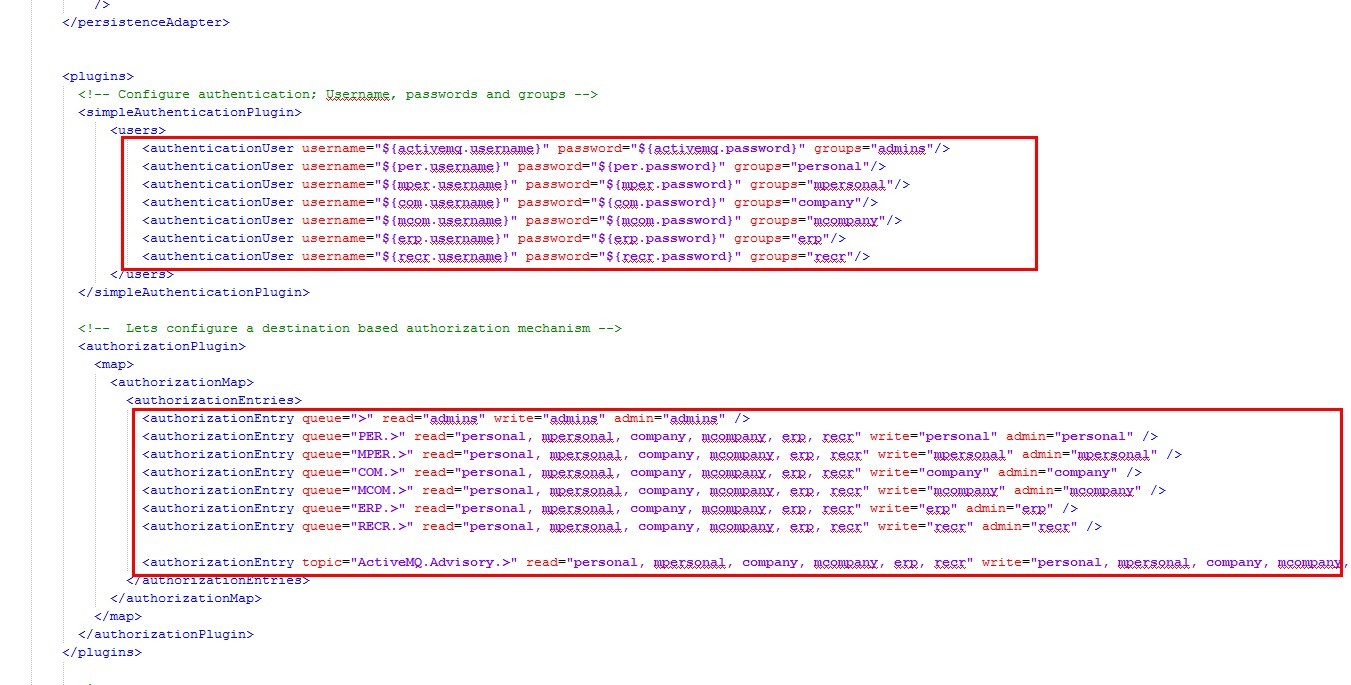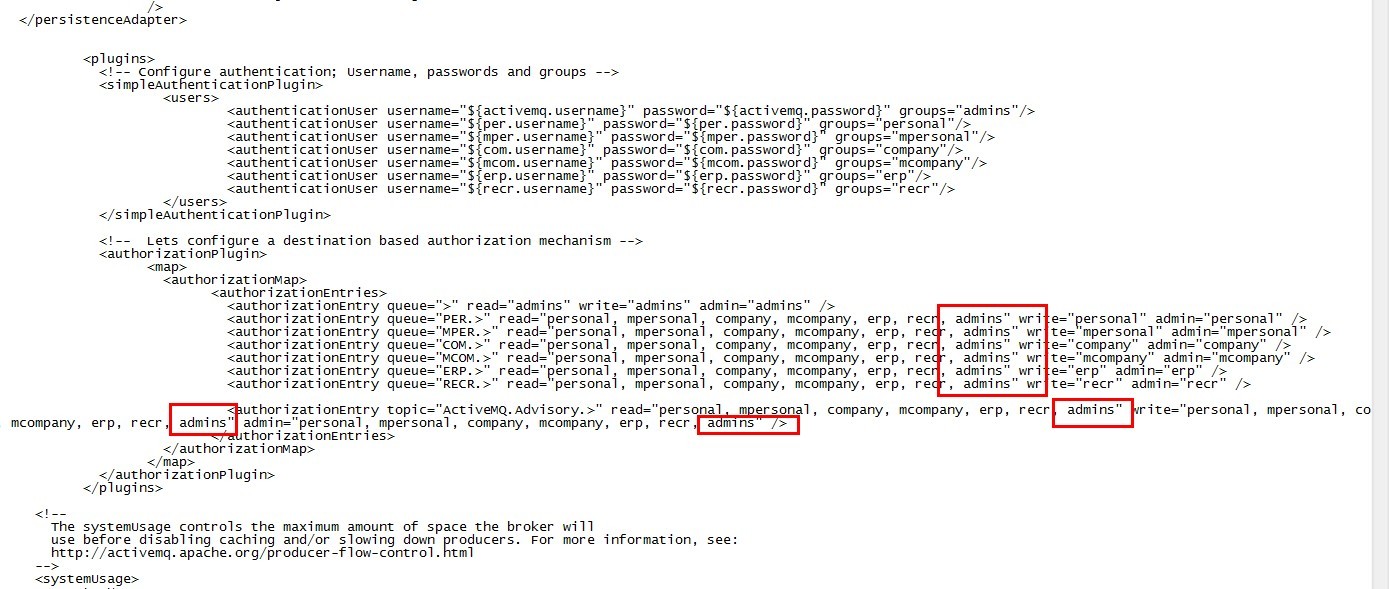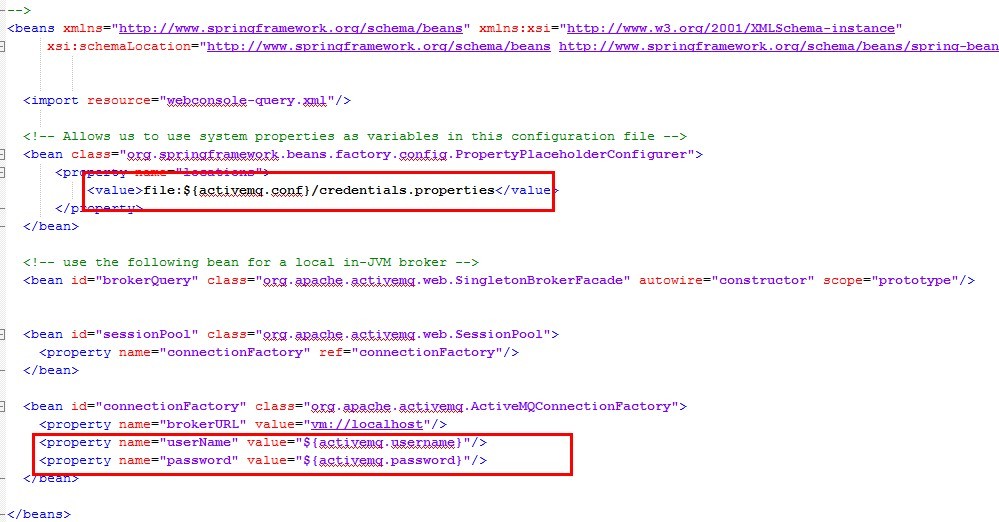ACTIVEMQ主题、队列设置用户名密码
修改文件%ACTIVEMQ_BASE%/conf/activemq.xml,用户名密码储存在文件%ACTIVEMQ_BASE%/conf/credentials.properties中,

activemq.xml详细如下:
<!--
Licensed to the Apache Software Foundation (ASF) under one or more
contributor license agreements. See the NOTICE file distributed with
this work for additional information regarding copyright ownership.
The ASF licenses this file to You under the Apache License, Version 2.0
(the "License"); you may not use this file except in compliance with
the License. You may obtain a copy of the License at
http://www.apache.org/licenses/LICENSE-2.0
Unless required by applicable law or agreed to in writing, software
distributed under the License is distributed on an "AS IS" BASIS,
WITHOUT WARRANTIES OR CONDITIONS OF ANY KIND, either express or implied.
See the License for the specific language governing permissions and
limitations under the License.
-->
<!-- START SNIPPET: example -->
<beans
xmlns="http://www.springframework.org/schema/beans"
xmlns:xsi="http://www.w3.org/2001/XMLSchema-instance"
xsi:schemaLocation="http://www.springframework.org/schema/beans http://www.springframework.org/schema/beans/spring-beans.xsd
http://activemq.apache.org/schema/core http://activemq.apache.org/schema/core/activemq-core.xsd">
<!-- Allows us to use system properties as variables in this configuration file -->
<bean class="org.springframework.beans.factory.config.PropertyPlaceholderConfigurer">
<property name="locations">
<value>file:${activemq.conf}/credentials.properties</value>
</property>
</bean>
<!-- Allows log searching in hawtio console -->
<bean id="logQuery" class="org.fusesource.insight.log.log4j.Log4jLogQuery"
lazy-init="false" scope="singleton"
init-method="start" destroy-method="stop">
</bean>
<!--
The <broker> element is used to configure the ActiveMQ broker.
-->
<broker xmlns="http://activemq.apache.org/schema/core" brokerName="localhost" dataDirectory="${activemq.data}" useJmx="true">
<destinationPolicy>
<policyMap>
<policyEntries>
<policyEntry queue=">" producerFlowControl="true" memoryLimit="1mb">
<!-- The constantPendingMessageLimitStrategy is used to prevent
slow topic consumers to block producers and affect other consumers
by limiting the number of messages that are retained
For more information, see:
http://activemq.apache.org/slow-consumer-handling.html
-->
<!-- 分发策略 -->
<dispatchPolicy>
<!-- 按顺序分发 -->
<strictOrderDispatchPolicy/>
</dispatchPolicy>
<!-- 恢复策略-->
<subscriptionRecoveryPolicy>
<!-- 只恢复最后一个message -->
<lastImageSubscriptionRecoveryPolicy/>
</subscriptionRecoveryPolicy>
<pendingQueuePolicy>
<!-- 首先在内存中保存消息的引用,如果内存使用量达到上限,那么会把消息引用保存到临时文件中 -->
<fileQueueCursor/>
</pendingQueuePolicy>
<pendingMessageLimitStrategy>
<constantPendingMessageLimitStrategy limit="1000"/>
</pendingMessageLimitStrategy>
</policyEntry>
<!-- 个人简历 -->
<policyEntry queue="PER.>" producerFlowControl="true" memoryLimit="10mb">
<!-- The constantPendingMessageLimitStrategy is used to prevent
slow topic consumers to block producers and affect other consumers
by limiting the number of messages that are retained
For more information, see:
http://activemq.apache.org/slow-consumer-handling.html
-->
<!-- 分发策略 -->
<dispatchPolicy>
<!-- 按顺序分发 -->
<strictOrderDispatchPolicy/>
</dispatchPolicy>
<!-- 恢复策略-->
<subscriptionRecoveryPolicy>
<!-- 只恢复最后一个message -->
<lastImageSubscriptionRecoveryPolicy/>
</subscriptionRecoveryPolicy>
<pendingQueuePolicy>
<!-- 首先在内存中保存消息的引用,如果内存使用量达到上限,那么会把消息引用保存到临时文件中 -->
<fileQueueCursor/>
</pendingQueuePolicy>
<pendingMessageLimitStrategy>
<constantPendingMessageLimitStrategy limit="1000"/>
</pendingMessageLimitStrategy>
</policyEntry>
<!-- 企业 -->
<policyEntry queue="COM.>" producerFlowControl="true" memoryLimit="10mb">
<!-- The constantPendingMessageLimitStrategy is used to prevent
slow topic consumers to block producers and affect other consumers
by limiting the number of messages that are retained
For more information, see:
http://activemq.apache.org/slow-consumer-handling.html
-->
<!-- 分发策略 -->
<dispatchPolicy>
<!-- 按顺序分发 -->
<strictOrderDispatchPolicy/>
</dispatchPolicy>
<!-- 恢复策略-->
<subscriptionRecoveryPolicy>
<!-- 只恢复最后一个message -->
<lastImageSubscriptionRecoveryPolicy/>
</subscriptionRecoveryPolicy>
<pendingQueuePolicy>
<!-- 首先在内存中保存消息的引用,如果内存使用量达到上限,那么会把消息引用保存到临时文件中 -->
<fileQueueCursor/>
</pendingQueuePolicy>
<pendingMessageLimitStrategy>
<constantPendingMessageLimitStrategy limit="1000"/>
</pendingMessageLimitStrategy>
</policyEntry>
<!-- 招聘会 -->
<policyEntry queue="RECR.>" producerFlowControl="true" memoryLimit="10mb">
<!-- The constantPendingMessageLimitStrategy is used to prevent
slow topic consumers to block producers and affect other consumers
by limiting the number of messages that are retained
For more information, see:
http://activemq.apache.org/slow-consumer-handling.html
-->
<!-- 分发策略 -->
<dispatchPolicy>
<!-- 按顺序分发 -->
<strictOrderDispatchPolicy/>
</dispatchPolicy>
<!-- 恢复策略-->
<subscriptionRecoveryPolicy>
<!-- 只恢复最后一个message -->
<lastImageSubscriptionRecoveryPolicy/>
</subscriptionRecoveryPolicy>
<pendingQueuePolicy>
<!-- 首先在内存中保存消息的引用,如果内存使用量达到上限,那么会把消息引用保存到临时文件中 -->
<fileQueueCursor/>
</pendingQueuePolicy>
<pendingMessageLimitStrategy>
<constantPendingMessageLimitStrategy limit="1000"/>
</pendingMessageLimitStrategy>
</policyEntry>
<!-- 微招聘 -->
<policyEntry queue="MCOM.>" producerFlowControl="true" memoryLimit="10mb">
<!-- The constantPendingMessageLimitStrategy is used to prevent
slow topic consumers to block producers and affect other consumers
by limiting the number of messages that are retained
For more information, see:
http://activemq.apache.org/slow-consumer-handling.html
-->
<!-- 分发策略 -->
<dispatchPolicy>
<!-- 按顺序分发 -->
<strictOrderDispatchPolicy/>
</dispatchPolicy>
<!-- 恢复策略-->
<subscriptionRecoveryPolicy>
<!-- 只恢复最后一个message -->
<lastImageSubscriptionRecoveryPolicy/>
</subscriptionRecoveryPolicy>
<pendingQueuePolicy>
<!-- 首先在内存中保存消息的引用,如果内存使用量达到上限,那么会把消息引用保存到临时文件中 -->
<fileQueueCursor/>
</pendingQueuePolicy>
<pendingMessageLimitStrategy>
<constantPendingMessageLimitStrategy limit="1000"/>
</pendingMessageLimitStrategy>
</policyEntry>
<!-- 微求职 -->
<policyEntry queue="MPER.>" producerFlowControl="true" memoryLimit="10mb">
<!-- The constantPendingMessageLimitStrategy is used to prevent
slow topic consumers to block producers and affect other consumers
by limiting the number of messages that are retained
For more information, see:
http://activemq.apache.org/slow-consumer-handling.html
-->
<!-- 分发策略 -->
<dispatchPolicy>
<!-- 按顺序分发 -->
<strictOrderDispatchPolicy/>
</dispatchPolicy>
<!-- 恢复策略-->
<subscriptionRecoveryPolicy>
<!-- 只恢复最后一个message -->
<lastImageSubscriptionRecoveryPolicy/>
</subscriptionRecoveryPolicy>
<pendingQueuePolicy>
<!-- 首先在内存中保存消息的引用,如果内存使用量达到上限,那么会把消息引用保存到临时文件中 -->
<fileQueueCursor/>
</pendingQueuePolicy>
<pendingMessageLimitStrategy>
<constantPendingMessageLimitStrategy limit="1000"/>
</pendingMessageLimitStrategy>
</policyEntry>
<!-- 后台 -->
<policyEntry queue="ERP.>" producerFlowControl="true" memoryLimit="10mb">
<!-- The constantPendingMessageLimitStrategy is used to prevent
slow topic consumers to block producers and affect other consumers
by limiting the number of messages that are retained
For more information, see:
http://activemq.apache.org/slow-consumer-handling.html
-->
<!-- 分发策略 -->
<dispatchPolicy>
<!-- 按顺序分发 -->
<strictOrderDispatchPolicy/>
</dispatchPolicy>
<!-- 恢复策略-->
<subscriptionRecoveryPolicy>
<!-- 只恢复最后一个message -->
<lastImageSubscriptionRecoveryPolicy/>
</subscriptionRecoveryPolicy>
<pendingQueuePolicy>
<!-- 首先在内存中保存消息的引用,如果内存使用量达到上限,那么会把消息引用保存到临时文件中 -->
<fileQueueCursor/>
</pendingQueuePolicy>
<pendingMessageLimitStrategy>
<constantPendingMessageLimitStrategy limit="1000"/>
</pendingMessageLimitStrategy>
</policyEntry>
</policyEntries>
</policyMap>
</destinationPolicy>
<!--
The managementContext is used to configure how ActiveMQ is exposed in
JMX. By default, ActiveMQ uses the MBean server that is started by
the JVM. For more information, see:
http://activemq.apache.org/jmx.html
-->
<managementContext>
<managementContext createConnector="false"/>
</managementContext>
<!--
Configure message persistence for the broker. The default persistence
mechanism is the KahaDB store (identified by the kahaDB tag).
For more information, see:
http://activemq.apache.org/persistence.html
-->
<persistenceAdapter>
<kahaDB directory="E:/activemq_data"
enableJournalDiskSyncs="false"
indexWriteBatchSize="1000"
indexCacheSize="10000"
journalMaxFileLength="32mb"
/>
</persistenceAdapter>
<plugins>
<!-- Configure authentication; Username, passwords and groups -->
<simpleAuthenticationPlugin>
<users>
<authenticationUser username="${activemq.username}" password="${activemq.password}" groups="admins"/>
<authenticationUser username="${per.username}" password="${per.password}" groups="personal"/>
<authenticationUser username="${mper.username}" password="${mper.password}" groups="mpersonal"/>
<authenticationUser username="${com.username}" password="${com.password}" groups="company"/>
<authenticationUser username="${mcom.username}" password="${mcom.password}" groups="mcompany"/>
<authenticationUser username="${erp.username}" password="${erp.password}" groups="erp"/>
<authenticationUser username="${recr.username}" password="${recr.password}" groups="recr"/>
</users>
</simpleAuthenticationPlugin>
<!-- Lets configure a destination based authorization mechanism -->
<authorizationPlugin>
<map>
<authorizationMap>
<authorizationEntries>
<authorizationEntry queue=">" read="admins" write="admins" admin="admins" />
<authorizationEntry queue="PER.>" read="personal, mpersonal, company, mcompany, erp, recr" write="personal" admin="personal" />
<authorizationEntry queue="MPER.>" read="personal, mpersonal, company, mcompany, erp, recr" write="mpersonal" admin="mpersonal" />
<authorizationEntry queue="COM.>" read="personal, mpersonal, company, mcompany, erp, recr" write="company" admin="company" />
<authorizationEntry queue="MCOM.>" read="personal, mpersonal, company, mcompany, erp, recr" write="mcompany" admin="mcompany" />
<authorizationEntry queue="ERP.>" read="personal, mpersonal, company, mcompany, erp, recr" write="erp" admin="erp" />
<authorizationEntry queue="RECR.>" read="personal, mpersonal, company, mcompany, erp, recr" write="recr" admin="recr" />
<authorizationEntry topic="ActiveMQ.Advisory.>" read="personal, mpersonal, company, mcompany, erp, recr" write="personal, mpersonal, company, mcompany, erp, recr" admin="personal, mpersonal, company, mcompany, erp, recr" />
</authorizationEntries>
</authorizationMap>
</map>
</authorizationPlugin>
</plugins>
<!--
The systemUsage controls the maximum amount of space the broker will
use before disabling caching and/or slowing down producers. For more information, see:
http://activemq.apache.org/producer-flow-control.html
-->
<systemUsage>
<systemUsage>
<memoryUsage>
<memoryUsage percentOfJvmHeap="100" />
</memoryUsage>
<storeUsage>
<storeUsage limit="1 gb"/>
</storeUsage>
<tempUsage>
<tempUsage limit="100 mb"/>
</tempUsage>
</systemUsage>
</systemUsage>
<!--
The transport connectors expose ActiveMQ over a given protocol to
clients and other brokers. For more information, see:
http://activemq.apache.org/configuring-transports.html
-->
<transportConnectors>
<!-- DOS protection, limit concurrent connections to 1000 and frame size to 100MB -->
<transportConnector name="openwire" uri="tcp://0.0.0.0:61616?maximumConnections=1000&wireFormat.maxFrameSize=104857600"/>
<transportConnector name="amqp" uri="amqp://0.0.0.0:5672?maximumConnections=1000&wireFormat.maxFrameSize=104857600"/>
<transportConnector name="stomp" uri="stomp://0.0.0.0:61613?maximumConnections=1000&wireFormat.maxFrameSize=104857600"/>
<transportConnector name="mqtt" uri="mqtt://0.0.0.0:1883?maximumConnections=1000&wireFormat.maxFrameSize=104857600"/>
<transportConnector name="ws" uri="ws://0.0.0.0:61614?maximumConnections=1000&wireFormat.maxFrameSize=104857600"/>
</transportConnectors>
<!-- destroy the spring context on shutdown to stop jetty -->
<shutdownHooks>
<bean xmlns="http://www.springframework.org/schema/beans" class="org.apache.activemq.hooks.SpringContextHook" />
</shutdownHooks>
</broker>
<!--
Enable web consoles, REST and Ajax APIs and demos
The web consoles requires by default login, you can disable this in the jetty.xml file
Take a look at ${ACTIVEMQ_HOME}/conf/jetty.xml for more details
-->
<import resource="jetty.xml"/>
</beans>
<!-- END SNIPPET: example -->
credentials.properties详细如下:
## ---------------------------------------------------------------------------
## Licensed to the Apache Software Foundation (ASF) under one or more
## contributor license agreements. See the NOTICE file distributed with
## this work for additional information regarding copyright ownership.
## The ASF licenses this file to You under the Apache License, Version 2.0
## (the "License"); you may not use this file except in compliance with
## the License. You may obtain a copy of the License at
##
## http://www.apache.org/licenses/LICENSE-2.0
##
## Unless required by applicable law or agreed to in writing, software
## distributed under the License is distributed on an "AS IS" BASIS,
## WITHOUT WARRANTIES OR CONDITIONS OF ANY KIND, either express or implied.
## See the License for the specific language governing permissions and
## limitations under the License.
## ---------------------------------------------------------------------------
# Defines credentials that will be used by components (like web console) to access the broker
activemq.username=***
activemq.password=***
per.username=***
per.password=***
mper.username=***
mper.password=***
com.username=***
com.password=***
mcom.username=***
mcom.password=***
erp.username=***
erp.password=***
recr.username=***
recr.password=***
以上配置今天发现队列监控出现异常,最后查到问题出现在这里:

由于队列监控项目admin里使用的账户为system/manager(webapps\admin\WEB-INF\webconsole-embedded.xml

),属于admins群组,需要加上权限。
ACTIVEMQ主题、队列设置用户名密码的更多相关文章
- windows下mongodb设置用户名密码&用python连接
环境: 主机:WIN10 python版本:3.5 mongodb版本:3.4.2 开发环境:pyCharm mongodb设置用户名密码: 编写mongodb配置文件mongodb.confdbpa ...
- 你的MongoDB Redis设置用户名密码了吗?看看shodan这款邪恶的搜索引擎吧!~
早上看新闻的时候看到了个醒目的新闻 开源中国:MongoDB 赎金事件持续发酵,究竟是谁之过? 博客园:MongoDB数据库勒索,中国受害者数量超乎你的想象,SOS! 1. 由于自己之前做过的项目,R ...
- ElasticSearch设置用户名密码访问
版本号:7.3.1 1.需要在配置文件中开启x-pack验证, 修改config目录下面的elasticsearch.yml文件,在里面添加如下内容,并重启. xpack.security.enabl ...
- eureka注册中心设置用户名密码
1.加入安全认证依赖 <dependency> <groupId>org.springframework.boot</groupId> <artifactId ...
- 创建一个MongoDB数据库再到配置成Window服务再设置用户名密码
1.安装MongoDB数据在官网下载安装 然后在C盘找到C:\Program Files\MongoDB\Server\4.0\bin这个可执行目录 使用cmd进入到这: 2.在C盘根目录创建一个名为 ...
- ActiveMQ修改连接的用户名密码
安装目录下conf/activemq.xml 添加如下内容: <plugins> <simpleAuthenticationPlugin> <users> < ...
- mongodb3 设置用户名密码 ,linux
--29T09:: I CONTROL [initandlisten] ** WARNING: You are running on a NUMA machine. --29T09:: I CONTR ...
- 不同版本的 Tomcat 设置用户名密码 的方法
Tomcat : tomcat根目录\conf\tomcat-users.xml,找到 <tomcat-users> 标签,在后面添加 <user username="ad ...
- ActiveMQ安全机制设置
一.设置后台管理密码a.ActiveMQ使用的是jetty服务器,找到D:\div\apache-activemq-5.11.1\conf\jetty.xml文件: <bean id=" ...
随机推荐
- Laravel5.5 使用队列 Queue
使用队列# 上一章节中我们开发了自动生成 Slug 功能,但是因为我们的需要实时请求百度翻译接口,这将会是一个系统性能隐患. 一般情况下,网络请求会存在各种不确定性,如果请求 API 出现超时情况,或 ...
- javac 编译java文件提示: 程序包com.mysql.jdbc不存在
需要将引用的包放到:/usr/java/jdk1.7.0_75/jre/lib/ext 也就是jdk安装目录/jre/lib/ext 目录下面
- 2018.10.23 NOIP模拟 战争(并查集)
传送门 跟bzoj1015: [JSOI2008]星球大战是同一道题啊讲道理. 随便合并一下就能过了. 代码
- DataGrid组件
<?xml version="1.0" encoding="utf-8"?><s:WindowedApplication xmlns:fx=& ...
- ansible api 调用出现ssh交互式输入
发现在删掉 ~/.ssh/know_hosts 之后运行 ansible api 会出现以下提示 The authenticity of host '10.1.*.* (10.1.*.*)' can' ...
- 控件无法安装的问题-Unable to execute file
官方网站:http://www.ncmem.com/ 产品首页:http://www.ncmem.com/webplug/wordpaster/ 产品介绍:http://www.cnblogs.com ...
- Linux 部署 tomcat 常用命令
1. 文件夹重命名 mv somedir somedir1 2. 授权所有子目录 chmod -R 777 somedir 3.授权单个目录 chmod 777 somedir 4.实时打印控制台日 ...
- Node.js是什么[译]
当我向人们介绍Node.js的时候,一般会有两种反应:多数立刻表示“哦,这样啊”,另外的则会感到困惑. 如果你是第二种的话,我会试着这样解释node: 这是一个命令行工具.你可以下载一个tar包,然后 ...
- strcpy,strlen, strcat, strcmp函数,strlen函数和sizeof的区别
//计算字符串实际长度 //strlen()函数:当遇到'\0'时,计算结束,'\0'不计入长度之内,如果你只定义没有给它赋初值,这个结果是不定的,它会从首地址一直找下去,直到遇到'\0 ...
- MSDN Webcast 跟我一起从零开始学WCF系列课程
系列课程 >跟我一起从零开始学WCF系列课程 跟我一起从零开始学WCF系列课程(1):WCF概述 (Level 200) 讲 师:徐长龙 课程简介:从 本堂课开始我们将开启一个新的 ...
